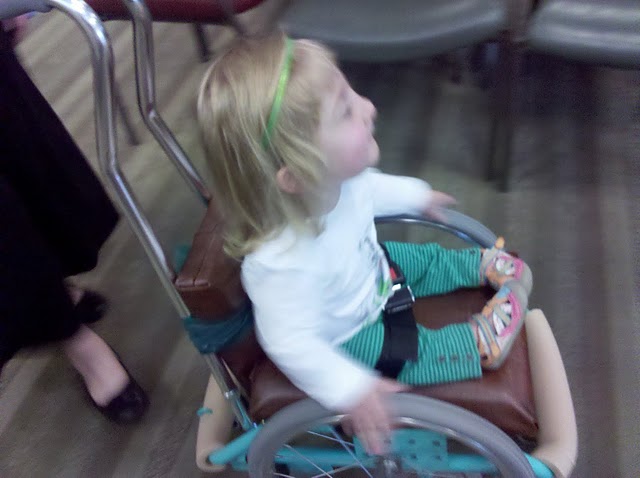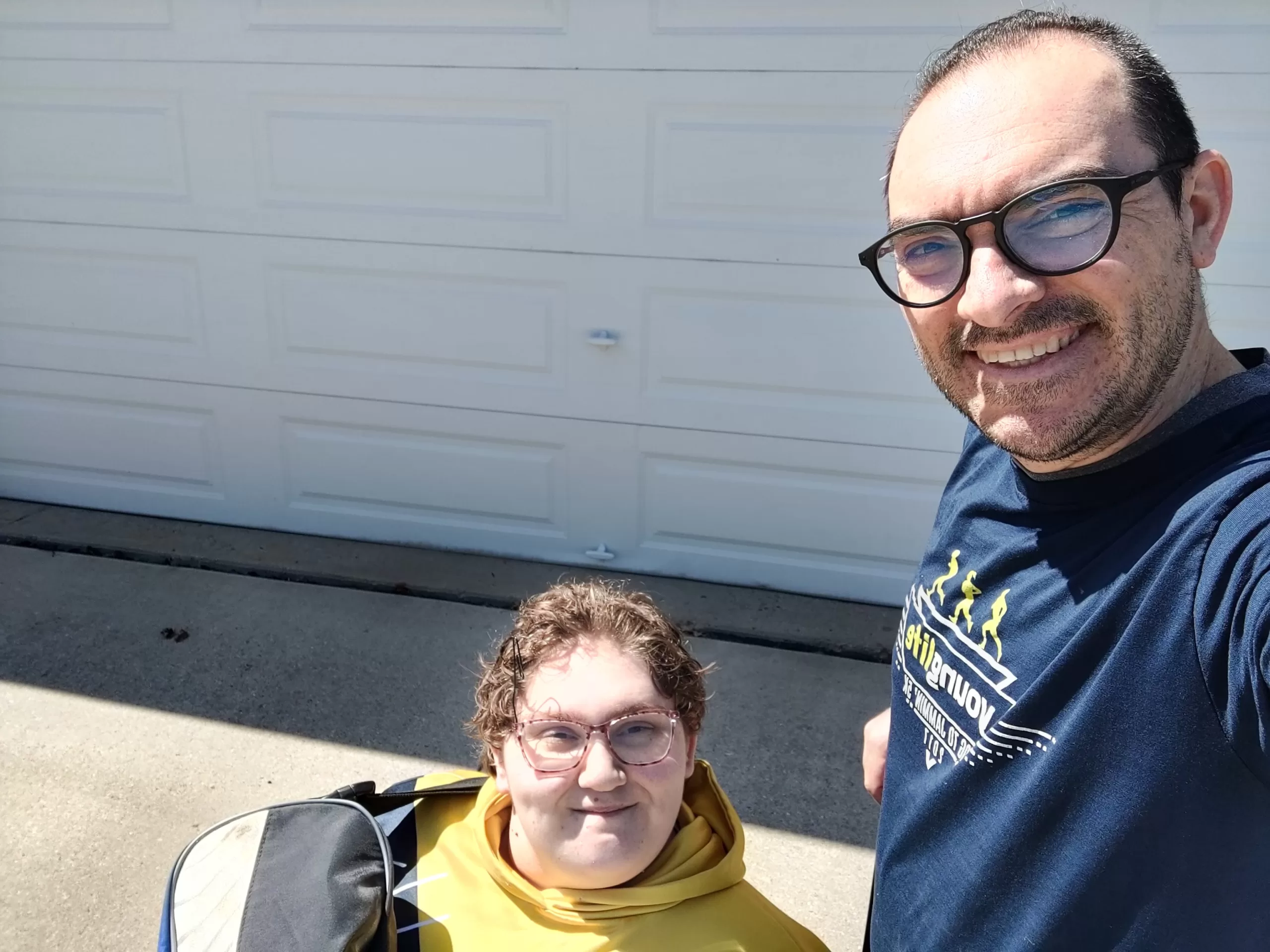I meant to talk about this some time ago, but you know how things are. Busy busy busy, that’s us. So anyway, apparently September 9 is Physical Therapy Day. I missed the date, perhaps, but it’s never too late to talk about the benefits of PT.
I don’t know if September 9 really is Physical Therapy Day or not. It seems like every other day is Celebrate Hamster Shaped Pancakes Day or something on Facebook, anyway. People repost (or retweet if that’s your thing) each others’ posts, and then no one knows where some of this stuff originated. But who cares? The way I see it, it doesn’t matter if it’s an offical Something Day. Physical therapy is on my mind, and that, along with the fact that it has greatly helped Namine, is reason enough to talk about it.
I suppose I should probably get the disclaimer out of the way. So here it is. I’m not working in any medical field or sub-field. I’m not a therapist, doctor, physician, pediatrician, pathologist, or nurse. I’m simply Namine’s dad, doing all I am able to learn all that I can. Just doing my best to help keep my daughter as healthy as possible, so she can do her best. That’s all. As I like to say: I’m not a professional, I just play one in real life.
Also, if you like reading, this post is for you. I’m not being deliberately long-winded; I just have a lot to say. Sorry. If you’re here for pictures of Namine, I would go here instead. Even if you do like reading my yammering, feel free to go there anyway. Namine is (I say with no bias whatsoever) an extremely adorable kid, and a bit (okay, more than a bit) of a camera diva. She definitely likes to have her picture taken.
Namine is ambidextrous, but I don’t think it’s a natural ambidextrosity. (Ambitextrousness? Ambidextricity? Hey, as long as we’re making stuff up as we go along, why not?) Since she was little, her right arm – which she nearly always favors, so leading me to think that under normal circumstances (normal? wuzzat?) she’d be right-handed – has been weak. But the reason for this, too, is not a natural occurrence. Namine was hospitalized for seven months after she was born. (Can you imagine it? You can’t. But you might imagine that you can imagine it.) The reason for this is two-fold: she has DILV (double inlet left ventricle heart defect) and Pierre Robin sequence (which caused the regressed jaw, partial cleft palate, small airway, and tiny ear canals. Also, I never know if I’m supposed to capitalize “sequence”).
During her time in the hospital, Namine had two heart surgeries (one indirect through her side and one open-heart), trach and g-tube placement, diaphragm plication, and tons of blood draws and a few transfusions – no matter what, after surgery she always needed a fresh transfusion or her O2 saturation levels would drop dramatically. Those are the major things, anyway.
Yes, I’m getting there. Shortly after birth, Namine had to have what’s known as a PICC line (although in my head it always appears as “pick line,” and I have no idea why). Long story short, the PICC line is there to provide doctors with intravenous access. It can’t stay in for very long – a few weeks to a month, and then it must come out – or it can cause complications. The longer it stays in, the higher the risk. And unfortunately, Namine suffered one long-term ill effect: her right shoulder is weak. It actually doesn’t even rotate fully, and it still causes her problems today. Her right arm gets tired easily, and so she will often switch between her right and left hands when carrying, drawing, putting puzzles together, and anything else you can think of that requires only one hand.
But before you have the reaction that I can’t stand – “awwwwww, that poor girl” – know it’s been this way her entire life. It’s what she knows; she’s overcome it and adapted to it. She’s never let a small thing like physical impossibility stop her before, and she’s not about to start any time soon.
And we owe it in no small part to her therapists. Through physical therapy, Namine has more strength now than ever before, and she is getting stronger. As vocal as she is now, she will sometimes tell us if something hurts. Her wrists in particular seem to bother her, but it’s never an “I can’t.” (With the exception of when she’s tired. When she’s overtired and crabby, all bets are off and she refuses to do anything.) She will simply tell me that her wrist hurts – sometimes it’s her elbow, but strangely enough she’s never once, to my recollection, complained of her shoulder – and then she’ll continue on with whatever it is that she’s doing. She’ll ask for a kiss on whatever may hurt, and then she’s done with the pain. She won’t complain about it. It’s just part of her life; it’s as much a part of her as her own limbs, but PT has helped her get past it. Therapy – at the hospital, at the PT clinic, and from Jessica and I at home – has helped her with tummy time; with teaching her to move on her own (I won’t say “teaching her to scoot,” because she learned on her own how best to move around); with rolling over; with standing and walking. Physical therapy has shown her that she is not limited. It has shown her that through her own strength and will, she can do anything.
We don’t balk at Namine standing and moving around. We may not always like what she climbs on (like that poor DVD player), but we never discourage her from climbing and attempting new things. By way of a for instance: when I give Namine a bath, she sits in a laundry basket inside the large tub. When she wanted to stand on her own in the bathtub, I told her to go ahead, assuring her that I was right there, holding the basket. She grabbed the sides of the basket and pushed herself up; a strong girl, and proud of it. Now she doesn’t merely stand anymore; she’s already taught herself to walk backward and forward in her basket. And she now does what we’ve been told is impossible*: she will alternate lifting her legs, kicking the water in her own one-girl chorus line.
* We’d been told from day one by Namine’s orthopedic doctor that both hips were dislocated; her femurs’ ball joints were nowhere near the sockets. As a result, she would never (without the aid of a pretty massive surgery) be able to move her legs at the hips joints. And what we saw from birth seemed to prove it: Namine could move her legs together, not independently, by moving her hips. Her leg movement was actually just hip movement.
In physical therapy, however, Namine started to prove that more may be possible. She not only stood (with the help of a walker and a lot of coaxing), but she took steps. As with anything, PT started off small (the term “baby steps” comes to mind, and in this case it’s literal), but Namine is now able to walk across the entire apartment in her walker.
But wait a minute, here. If her hips are dislocated, how is this possible? We just went with it. We were used to Namine defying what doctors had declared possible, after all. No one could have foreseen how caudal regression would save Namine’s life from her heart defect, so we just chalked this up as something else we didn’t understand now. We hoped that someday we would understand, but it wasn’t important. What is important is that Namine was able to walk. Not on her own, not yet, but it was a start, and she loved it.
Fast forward a little past Namine’s third birthday. Being fed up with the first ortho doctor’s crap (he botched her foot surgery and was not at all a good doctor), we switched to a different ortho. According to him, Namine’s hips might not be dislocated, after all. It’s hard to tell, he said, but the fact that Namine is starting to walk means there’s a good possibility that her hips are pretty nicely situated, especially given her typically morbid doctor predictions.




Leave a Reply